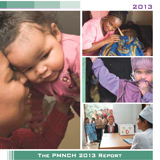
Analysing Progress on Commitments to the Global Strategy for Women’s and Children’s Health
The Global Strategy for Women’s and Children’s Health (Global Strategy), launched by the United Nations (UN) Secretary-General Ban Ki-moon in September 2010, aims to save 16 million lives in 49 countries by 2015 through enhanced financing, strengthened policy and improved service delivery. These 49 countries were the poorest countries according to the World Bank’s list of economies as of April 2008. The Every Woman Every Child movement was established at the same time to mobilize and intensify the international and national action needed to advance the Global Strategy. The direct costs and the health systems costs for programmes and services targeting women and children in the 49 countries were estimated to be US$ 88 billion for 2011-2015 (excluding costs for scaling up to meet other health MDGs*).
This report is the third annual report produced by the Partnership for Maternal, Newborn & Child Health (PMNCH) analysing the commitments made by countries and development partners to the Global Strategy and Every Woman Every Child. The PMNCH 2012 report contributed to the independent Expert Review Group (iERG)’s first annual report to the UN Secretary-General. The iERG requested PMNCH to produce a 2013 report on the progress of the implementation of commitments to the Global Strategy.
The main objective of this year’s report is to assess the extent to which the 293 stakeholders who have made commitments to the Global Strategy since its launch in 2010 (up to June 2013) have implemented their commitments, and the extent to which implementation is contributing to reaching the goals of the Global Strategy. It is not a comprehensive stocktaking of all that is being done at national, regional and global levels to improve women’s and children’s health.
The content of the report is based on a range of information sources and data collection methods as relevant to the nature of the individual commitments and their implementation. The methods used were: a content analysis of all commitment statements from the Every Woman Every Child website; an online survey sent to commitment-makers, of which 120 fully completed the survey; detailed interviews based on semi-structured questionnaires with a selection of stakeholders; and an extensive desk review of relevant literature and databases.